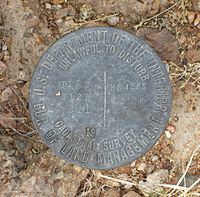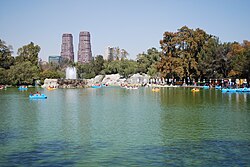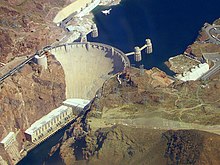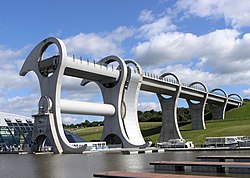سول انجنيئرنگ
| هن مضمون کي وڌيڪ حوالن جي ضرورت آهي ته جيئن حقيقتن جي تصديق ڪري سگهجي. (July 2022) |

سول انجنيئرنگ (Civil Engineering) هڪ پروفيشنل انجنيئرنگ ڊسيپلن آهي جيڪو طبعي ۽ قدرتي طور تي ٺهيل ماحول جي ڊيزائن، تعمير ۽ سار سنڀال سان واسطو رکي ٿو، جنهن ۾ عوامي ڪم جهڙوڪ روڊ، پل، واهن، ڊيم، ايئرپورٽ، سيوريج سسٽم، پائپ لائنون، عمارتن جا ساختي حصا ۽ ريلوي شامل آھن.[1] [2]
سول انجنيئرنگ روايتي طور تي ڪيترن ئي ذيلي شعبن ۾ ورهايل آهي. ان کي فوجي انجنيئرنگ کان پوءِ ٻيو پراڻو انجنيئرنگ ڊسيپلين سمجهيو ويندو آهي، [3] ۽ ان کي غير فوجي انجنيئرنگ کان فوجي انجنيئرنگ ۾ فرق ڪرڻ جي تعريف ڪئي وئي آهي.[4] سول انجنيئرنگ عوامي شعبي ۾ ميونسپل پبلڪ ورڪس ڊپارٽمنٽ کان وٺي وفاقي حڪومتي ادارن تائين، ۽ خانگي شعبي ۾ مقامي طور تي ٻڌل فرمن کان فارچون گلوبل 500 ڪمپنين تائين ٿي سگھي ٿي.[5]
تاريخ
[سنواريو]تعليم
[سنواريو]عملي انجنيئر
[سنواريو]ذيلي شعبا
[سنواريو]
سول انجنيئرنگ جي وسيع فيلڊ ۾ ڪيترائي ذيلي شعبا آهن. جنرل سول انجنيئر سروي ڪندڙن ۽ خاص سول انجنيئرن سان ويجهڙائي سان گريڊنگ، نيڪال، فرش، پاڻي جي فراهمي، سيوريج سروس، ڊيم، بجلي ۽ مواصلاتي سپلائي کي ڊزائين ڪرڻ لاء ڪم ڪن ٿا. جنرل سول انجنيئرنگ کي سائيٽ انجنيئرنگ پڻ سڏيو ويندو آهي، سول انجنيئرنگ جي هڪ شاخ جيڪا بنيادي طور تي زمين جي هڪ ٽڪري کي هڪ استعمال کان ٻئي ۾ تبديل ڪرڻ تي ڌيان ڏئي ٿي. سائيٽ انجنيئر پروجيڪٽ سائيٽن جو دورو ڪرڻ، اسٽيڪ هولڊرز سان ملڻ، ۽ تعميراتي منصوبا تيار ڪرڻ ۾ وقت گذاريندا آهن. سول انجنيئر جيو ٽيڪنيڪل انجنيئرنگ، ڍانچي جی انجنيئرنگ، ماحولياتي انجنيئرنگ، ٽرانسپورٽ انجنيئرنگ ۽ تعميراتي انجنيئرنگ جي اصولن کي رهائشي، تجارتي، صنعتي ۽ عوامي ڪم جي منصوبن تي سڀني سائزن ۽ تعمير جي سطحن تي لاڳو ڪن ٿا.
ساحلي انجنيئرنگ
[سنواريو]- اصل مضمون/مضمونن جي لاءِ ڏسو ساحلي انجنيئرنگ ۽ ساحلي انتظام

ساحلي انجنيئرنگ جو تعلق ساحلي علائقن جي انتظام سان آهي. ڪجهه دائري اختيار ۾، اصطلاحن ۾ سامونڊي دفاع ۽ ساحلي تحفظ جو مطلب آهي، ترتيب سان ٻوڏ ۽ تباهي جي خلاف دفاع. ساحلي دفاع وڌيڪ روايتي اصطلاح آهي، پر ساحلي انتظام پڻ مشهور ٿي چڪو آهي.
تعميراتي انجنيئرنگ
[سنواريو]تعميراتي انجنيئرنگ ۾ منصوبابندي ۽ عمل، مواد جي نقل و حمل، سائيٽ جي ترقي جي بنياد تي هائڊرولڪ، ماحولياتي، ساختماني ۽ جيوٽيڪنيڪل انجنيئرنگ شامل آهي. جيئن ته تعميراتي ڪمپنيون ٻين قسمن جي سول انجنيئرنگ فرمن جي ڀيٽ ۾ وڌيڪ ڪاروبار جو خطرو رکن ٿيون، تعميراتي انجنيئر اڪثر ڪري وڌيڪ ڪاروبار جھڙوڪ ٽرانزيڪشن ۾ مشغول ڪندا آهن، مثال طور، مسودو تيار ڪرڻ ۽ معاهدن جو جائزو وٺڻ، لوجسٽڪ آپريشن جو جائزو وٺڻ ۽ سپلائي جي قيمتن جي نگراني ڪرڻ.
زلزلي جي انجنيئرنگ
[سنواريو]زلزلي جي انجنيئرنگ ۾ خطرناڪ زلزلي جي نمائش کي منهن ڏيڻ لاءِ اڏاوتن کي ڊزائين ڪرڻ شامل آهي. زلزلي جي انجنيئرنگ ساخت جي انجنيئرنگ جو هڪ ذيلي نظم آهي. زلزلي جي انجنيئرنگ جا بنيادي مقصد لڪل زمين تي اڏاوتن جي رابطي کي سمجهڻ؛ ممڪن زلزلن جي نتيجن جي اڳڪٿي؛ ۽ عمارتن جي ضابطن جي تعميل ۾ زلزلي تي انجام ڏيڻ لاءِ جوڙجڪ، تعمير ۽ برقرار رکڻ آهن.
ماحولياتي انجنيئرنگ
[سنواريو]
Environmental engineering is the contemporary term for sanitary engineering, though sanitary engineering traditionally had not included much of the hazardous waste management and environmental remediation work covered by environmental engineering. Public health engineering and environmental health engineering are other terms being used.
Environmental engineering deals with treatment of chemical, biological, or thermal wastes, purification of water and air, and remediation of contaminated sites after waste disposal or accidental contamination. Among the topics covered by environmental engineering are pollutant transport, water purification, waste water treatment, air pollution, solid waste treatment, recycling, and hazardous waste management. Environmental engineers administer pollution reduction, green engineering, and industrial ecology. Environmental engineers also compile information on environmental consequences of proposed actions.
Forensic engineering===
- اصل مضمون جي لاءِ ڏسو Forensic engineering
Forensic engineering is the investigation of materials, products, structures or components that fail or do not operate or function as intended, causing personal injury or damage to property. The consequences of failure are dealt with by the law of product liability. The field also deals with retracing processes and procedures leading to accidents in operation of vehicles or machinery. The subject is applied most commonly in civil law cases, although it may be of use in criminal law cases. Generally the purpose of a Forensic engineering investigation is to locate cause or causes of failure with a view to improve performance or life of a component, or to assist a court in determining the facts of an accident. It can also involve investigation of intellectual property claims, especially patents.
Geotechnical engineering===
- اصل مضمون جي لاءِ ڏسو Geotechnical engineering

Geotechnical engineering studies rock and soil supporting civil engineering systems. Knowledge from the field of soil science, materials science, mechanics, and hydraulics is applied to safely and economically design foundations, retaining walls, and other structures. Environmental efforts to protect groundwater and safely maintain landfills have spawned a new area of research called geo-environmental engineering.[6][7]
Identification of soil properties presents challenges to geotechnical engineers. Boundary conditions are often well defined in other branches of civil engineering, but unlike steel or concrete, the material properties and behavior of soil are difficult to predict due to its variability and limitation on investigation. Furthermore, soil exhibits nonlinear (stress-dependent) strength, stiffness, and dilatancy (volume change associated with application of shear stress), making studying soil mechanics all the more difficult.[6] Geotechnical engineers frequently work with professional geologists, Geological Engineering professionals and soil scientists.[8]
Materials science and engineering:
- اصل مضمون جي لاءِ ڏسو Materials science
Materials science is closely related to civil engineering. It studies fundamental characteristics of materials, and deals with ceramics such as concrete and mix asphalt concrete, strong metals such as aluminum and steel, and thermosetting polymers including polymethylmethacrylate (PMMA) and carbon fibers.
Materials engineering involves protection and prevention (paints and finishes). Alloying combines two types of metals to produce another metal with desired properties. It incorporates elements of applied physics and chemistry. With recent media attention on nanoscience and nanotechnology, materials engineering has been at the forefront of academic research. It is also an important part of forensic engineering and failure analysis.
Site development and planning===

Site development, also known as site planning, is focused on the planning and development potential of a site as well as addressing possible impacts from permitting issues and environmental challenges.[9]
Structural engineering===
- اصل مضمون جي لاءِ ڏسو Structural engineering
Structural engineering is concerned with the structural design and structural analysis of buildings, bridges, towers, flyovers (overpasses), tunnels, off shore structures like oil and gas fields in the sea, aerostructure and other structures. This involves identifying the loads which act upon a structure and the forces and stresses which arise within that structure due to those loads, and then designing the structure to successfully support and resist those loads. The loads can be self weight of the structures, other dead load, live loads, moving (wheel) load, wind load, earthquake load, load from temperature change etc. The structural engineer must design structures to be safe for their users and to successfully fulfill the function they are designed for (to be serviceable). Due to the nature of some loading conditions, sub-disciplines within structural engineering have emerged, including wind engineering and earthquake engineering.[10]
Design considerations will include strength, stiffness, and stability of the structure when subjected to loads which may be static, such as furniture or self-weight, or dynamic, such as wind, seismic, crowd or vehicle loads, or transitory, such as temporary construction loads or impact. Other considerations include cost, constructibility, safety, aesthetics and sustainability.
Surveying===
- اصل مضمون/مضمونن جي لاءِ ڏسو Surveying ۽ Construction surveying
Surveying is the process by which a surveyor measures certain dimensions that occur on or near the surface of the Earth. Surveying equipment such as levels and theodolites are used for accurate measurement of angular deviation, horizontal, vertical and slope distances. With computerisation, electronic distance measurement (EDM), total stations, GPS surveying and laser scanning have to a large extent supplanted traditional instruments. Data collected by survey measurement is converted into a graphical representation of the Earth's surface in the form of a map. This information is then used by civil engineers, contractors and realtors to design from, build on, and trade, respectively. Elements of a structure must be sized and positioned in relation to each other and to site boundaries and adjacent structures.
Although surveying is a distinct profession with separate qualifications and licensing arrangements, civil engineers are trained in the basics of surveying and mapping, as well as geographic information systems. Surveyors also lay out the routes of railways, tramway tracks, highways, roads, pipelines and streets as well as position other infrastructure, such as harbors, before construction.
- Land surveying
In the United States, Canada, the United Kingdom and most Commonwealth countries land surveying is considered to be a separate and distinct profession. Land surveyors are not considered to be engineers, and have their own professional associations and licensing requirements. The services of a licensed land surveyor are generally required for boundary surveys (to establish the boundaries of a parcel using its legal description) and subdivision plans (a plot or map based on a survey of a parcel of land, with boundary lines drawn inside the larger parcel to indicate the creation of new boundary lines and roads), both of which are generally referred to as Cadastral surveying.

- Construction surveying
Construction surveying is generally performed by specialized technicians. Unlike land surveyors, the resulting plan does not have legal status. Construction surveyors perform the following tasks:
- Surveying existing conditions of the future work site, including topography, existing buildings and infrastructure, and underground infrastructure when possible;
- "lay-out" or "setting-out": placing reference points and markers that will guide the construction of new structures such as roads or buildings;
- Verifying the location of structures during construction;
- As-Built surveying: a survey conducted at the end of the construction project to verify that the work authorized was completed to the specifications set on plans.
Transportation engineering===
- اصل مضمون جي لاءِ ڏسو Transportation engineeringTransportation engineering is concerned with moving people and goods efficiently, safely, and in a manner conducive to a vibrant community. This involves specifying, designing, constructing, and maintaining transportation infrastructure which includes streets, canals, highways, rail systems, airports, ports, and mass transit. It includes areas such as transportation design, transportation planning, traffic engineering, some aspects of urban engineering, queueing theory, pavement engineering, Intelligent Transportation System (ITS), and infrastructure management.
Municipal or urban engineering===

- اصل مضمون جي لاءِ ڏسو Urban engineering

Municipal engineering is concerned with municipal infrastructure. This involves specifying, designing, constructing, and maintaining streets, sidewalks, water supply networks, sewers, street lighting, municipal solid waste management and disposal, storage depots for various bulk materials used for maintenance and public works (salt, sand, etc.), public parks and cycling infrastructure. In the case of underground utility networks, it may also include the civil portion (conduits and access chambers) of the local distribution networks of electrical and telecommunications services. It can also include the optimization of waste collection and bus service networks. Some of these disciplines overlap with other civil engineering specialties, however municipal engineering focuses on the coordination of these infrastructure networks and services, as they are often built simultaneously, and managed by the same municipal authority. Municipal engineers may also design the site civil works for large buildings, industrial plants or campuses (i.e. access roads, parking lots, potable water supply, treatment or pretreatment of waste water, site drainage, etc.)
Water resources engineering===

Water resources engineering is concerned with the collection and management of water (as a natural resource). As a discipline it therefore combines elements of hydrology, environmental science, meteorology, conservation, and resource management. This area of civil engineering relates to the prediction and management of both the quality and the quantity of water in both underground (aquifers) and above ground (lakes, rivers, and streams) resources. Water resource engineers analyze and model very small to very large areas of the earth to predict the amount and content of water as it flows into, through, or out of a facility. Although the actual design of the facility may be left to other engineers.
Hydraulic engineering is concerned with the flow and conveyance of fluids, principally water. This area of civil engineering is intimately related to the design of pipelines, water supply network, drainage facilities (including bridges, dams, channels, culverts, levees, storm sewers), and canals. Hydraulic engineers design these facilities using the concepts of fluid pressure, fluid statics, fluid dynamics, and hydraulics, among others.

Civil engineering systems=== Civil engineering systems is a discipline that promotes the use of systems thinking to manage complexity and change in civil engineering within its wider public context. It posits that the proper development of civil engineering infrastructure requires a holistic, coherent understanding of the relationships between all of the important factors that contribute to successful projects while at the same time emphasizing the importance of attention to technical detail. Its purpose is to help integrate the entire civil engineering project life cycle from conception, through planning, designing, making, operating to decommissioning.[11][12]
پڻ ڏسو
[سنواريو]خارجي لنڪس
[سنواريو]| وڪي قول ۾ سول انجنيئرنگ جي متعلق قول موجود آھي۔ |
| لائبريري وسيلا بابت سول انجنيئرنگ |
- The Institution of Civil Engineers
- Civil Engineering Software Database
- The Institution of Civil Engineering Surveyors آرڪائيو ڪيا ويا 2009-11-05 حوالو موجود آهي وي بيڪ مشين.
- Civil engineering classes, from MIT OpenCourseWare
حوالا
[سنواريو]- ↑ "History and Heritage of Civil Engineering". American Society of Civil Engineers. وقت 16 February 2007 تي اصل کان آرڪائيو ٿيل. حاصل ڪيل 2007-08-08.
- ↑ "What is Civil Engineering". Institution of Civil Engineers. حاصل ڪيل 2017-05-15.
- ↑ "What is Civil Engineering?". Canadian Society for Civil Engineering. وقت 12 August 2007 تي اصل کان آرڪائيو ٿيل. حاصل ڪيل 2007-08-08.
- ↑ "Civil engineering". Encyclopædia Britannica. حاصل ڪيل 2007-08-09.
- ↑ "Working in the Public Sector Versus Private Sector for Civil Engineering Professionals". The Civil Engineering Podcast. Engineering Management Institute.
- ↑ 6.0 6.1 Mitchell, James Kenneth (1993). Fundamentals of Soil Behavior (2nd ed.). John Wiley and Sons. pp. 1–2.
- ↑ Shroff, Arvind V.; Shah, Dhananjay L. (2003). Soil Mechanics and Geotechnical Engineering. Taylor & Francis. pp. 1–2.
- ↑ "Geotechnical/Geological Engineering" (PDF). Professional Careers in the Mineral Industry. The Australasian Institute of Mining and Metallurgy. وقت 2008-07-20 تي اصل (PDF) کان آرڪائيو ٿيل. حاصل ڪيل 30 May 2018. Unknown parameter
|url-status=ignored (مدد) - ↑ "Site Development and Planning". Nobis Group. حاصل ڪيل September 7, 2020.
- ↑ Narayanan, R; Beeby, A (2003). Introduction to Design for Civil Engineers. London: Spon.
- ↑ Labi, Samuel (2014). Introduction to Civil Engineering Systems: A Systems Perspective to the Development of Civil Engineering Facilities. John Wiley. ISBN 978-0-470-53063-4. https://www.wiley.com/en-us/Introduction+to+Civil+Engineering+Systems%3A+A+Systems+Perspective+to+the+Development+of+Civil+Engineering+Facilities-p-9780470530634.
- ↑ Blockley, David; Godfrey, Patrick (2017). Doing it Differently: Systems for Rethinking Infrastructure (2nd ed.). London: ICE Publications. ISBN 978-0-7277-6082-1.
- غيرمددي پيراميٽر سان حوالا تي مشتمل صفحا
- اضافي حوالن جي ضرورت جا صفحا from July 2022
- Articles with invalid date parameter in template
- LCCN سان سڃاڻپ ڪندڙ وڪيپيڊيا مضمون
- GND سان سڃاڻپ ڪندڙ وڪيپيڊيا مضمون
- BNF سان سڃاڻپ ڪندڙ وڪيپيڊيا مضمون
- Civil engineering
- Engineering disciplines
- Articles containing video clips
- انجنيئرنگ
- انجنيئرنگ جا شعبا
